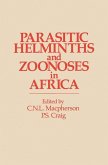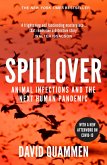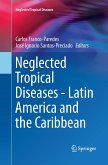Neglected Parasitic Zoonoses of Helminth Origin
Herausgeber: De, Arun Kumar; Gupta, Snehil; Ponraj, Perumal; Bhattacharya, Debasis
Neglected Parasitic Zoonoses of Helminth Origin
Herausgeber: De, Arun Kumar; Gupta, Snehil; Ponraj, Perumal; Bhattacharya, Debasis
- Gebundenes Buch
- Merkliste
- Auf die Merkliste
- Bewerten Bewerten
- Teilen
- Produkt teilen
- Produkterinnerung
- Produkterinnerung
This book offers a comprehensive analysis of neglected parasitic zoonoses of helminthic origin, emphasizing the One Health perspective. It covers epidemiology, pathology, disease control, diagnosis, prevention strategies, and implications for public health, making it essential for researchers and healthcare professionals.
Andere Kunden interessierten sich auch für
![Parasitic helminths and zoonoses in Africa Parasitic helminths and zoonoses in Africa]() Parasitic helminths and zoonoses in Africa113,99 €
Parasitic helminths and zoonoses in Africa113,99 €![Spillover Spillover]() David QuammenSpillover11,99 €
David QuammenSpillover11,99 €![Zika and Other Neglected and Emerging Flaviviruses Zika and Other Neglected and Emerging Flaviviruses]() Lisa A. BeltzZika and Other Neglected and Emerging Flaviviruses55,99 €
Lisa A. BeltzZika and Other Neglected and Emerging Flaviviruses55,99 €![Malaria, a Neglected Factor in the History of Greece and Rome Malaria, a Neglected Factor in the History of Greece and Rome]() Ronald RossMalaria, a Neglected Factor in the History of Greece and Rome28,99 €
Ronald RossMalaria, a Neglected Factor in the History of Greece and Rome28,99 €![Parasitic Protozoa Parasitic Protozoa]() J. P. KreierParasitic Protozoa39,99 €
J. P. KreierParasitic Protozoa39,99 €![Neglected Tropical Diseases - Latin America and the Caribbean Neglected Tropical Diseases - Latin America and the Caribbean]() Neglected Tropical Diseases - Latin America and the Caribbean121,99 €
Neglected Tropical Diseases - Latin America and the Caribbean121,99 €![On Infective and 'contagium' Diseases and Parasites in Man and Animals, by Dr. Acland and On the Rot Or Parasitic Liver Disease in Sheep, by A.P.Thomas [Lectures] On Infective and 'contagium' Diseases and Parasites in Man and Animals, by Dr. Acland and On the Rot Or Parasitic Liver Disease in Sheep, by A.P.Thomas [Lectures]]() Henry Wentworth AclandOn Infective and 'contagium' Diseases and Parasites in Man and Animals, by Dr. Acland and On the Rot Or Parasitic Liver Disease in Sheep, by A.P.Thomas [Lectures]27,99 €
Henry Wentworth AclandOn Infective and 'contagium' Diseases and Parasites in Man and Animals, by Dr. Acland and On the Rot Or Parasitic Liver Disease in Sheep, by A.P.Thomas [Lectures]27,99 €-
-
-
This book offers a comprehensive analysis of neglected parasitic zoonoses of helminthic origin, emphasizing the One Health perspective. It covers epidemiology, pathology, disease control, diagnosis, prevention strategies, and implications for public health, making it essential for researchers and healthcare professionals.
Produktdetails
- Produktdetails
- Verlag: Taylor & Francis Ltd
- Seitenzahl: 288
- Erscheinungstermin: 18. Dezember 2025
- Englisch
- Abmessung: 280mm x 210mm
- ISBN-13: 9781032670805
- ISBN-10: 1032670800
- Artikelnr.: 74446191
- Herstellerkennzeichnung
- Libri GmbH
- Europaallee 1
- 36244 Bad Hersfeld
- gpsr@libri.de
- Verlag: Taylor & Francis Ltd
- Seitenzahl: 288
- Erscheinungstermin: 18. Dezember 2025
- Englisch
- Abmessung: 280mm x 210mm
- ISBN-13: 9781032670805
- ISBN-10: 1032670800
- Artikelnr.: 74446191
- Herstellerkennzeichnung
- Libri GmbH
- Europaallee 1
- 36244 Bad Hersfeld
- gpsr@libri.de
Debasis Bhattacharya, Principal Scientist of ICAR-Central Island Agricultural Research Institute is actively involved in research, teaching and extension for more than thirty years. He is an expert in molecular parasitology, worked on immunoinformatics approaches and immunodiagnostics, mitogenome analysis through super gene approach and ecotoxicology as well. His recent contribution in molecular genetics on characterization of endemic species of Andaman and Nicobar Islands is noteworthy and has been published in reputed peer reviewed journals. He has worked extensively for more than a decade on cystic echinococcosis on its gene expression pattern, molecular identification of parasite, drug read out system and development of immunodiagnostics. He has guided three MVSc students of ICAR-IVRI deemed University and two PhD students of University of Kolkata. He has published near about 80 research publications in national and international journals and has got three Indian patents and one Industrial design. Snehil Gupta, PhD is an Assistant Professor at the College of Veterinary Science, Lala Lajpat Rai University of Veterinary and Animal Sciences, Hisar, India. With over 9 years of research experience, Dr. Gupta has published more than 50 research articles, credited with several book chapters, review articles, practical manuals, and two authored books. He is a recipient of the Dr. J.P. Dubey Young Scientist Award, LUVAS Merit Gold Medal, Dr. D.P. Banerjee Gold Medal, Dr. B.D. Bahl Gold Medal, Prof. P.K. Dwarkanath Memorial Gold Medal, Neomec Project Shiksha Scholarship, Xceft Merit award and other prestigious awards during his academic journey. He also served as Associate editor for The Haryana Veterinarian Journal and reviewer for several journals on international repute. His research focuses on acaricide resistance, molecular parasitology, and drug development against protozoan parasites. Arun Kumar De, PhD, University of Illinois, Urbana-Champaign, USA is currently working as a 'Senior Scientist' at ICAR-Central Island Agricultural Research Institute, Sri Vijaya Puram, A & N Islands, India. His research focuses on molecular characterization of neglected and zoonotic parasites as well as depiction of molecular basis of host-parasite interaction. With over 15 years of research experience, Dr. De has published more than 100 research articles, credited with several book chapters, review articles, practical manuals, and two authored books. Perumal Ponraj, MVSc, PhD is a Senior Scientist at ICAR-Central Island Agricultural Research Institute, Sri Vijaya Puram, Andaman and Nicobar Islands, India. With over 13 years of research experience, Dr. Perumal Ponraj has published more than 100 research articles, credited with several book chapters, review articles, folders & leaflets, practical manuals, and authored and edited books. He is a recipient of the Young Scientist Award (NAVS-I), Prof. N. R. Moudgal Young Scientist Award (ISSRF), Dr. G. B. Singh Memorial Award (ISSAR), Best Faculty Research Award (Careers360) and other prestigious awards during his academic journey. He also served as an Academic Editor of Veterinary Medicine International, Andrologia, and other Journals, editorial board member of different Journals and Guest Editor of AAVS, JEBAS and Life (MDPI) and reviewer for several journals on international repute. His research focuses on semen biology, meteorology and climatology on reproduction and reproductive biotechnology in livestock species.
An introductory note on Neglected Parasitic Zoonoses. 2. Emerging
helminthic zoonoses and notable recent outbreaks. 3. Zoonotic helminths and
One Health perspective. 4. Ecological aspects of helminth zoonoses. 5.
Socioeconomic impact of Neglected Tropical Helminth Zoonoses (NTHZ). 6.
Global Initiatives in Curtailing Zoonotic Cases of Helminth Origin. 7.
Fascioliasis and Fasciolopsiasis. 8. Amphistomiasis and Dicrocoeliasis. 9.
Schistosomosis. 10. Opisthorchiasis. 11. Clonorchiasis. 12. Metagonimiasis,
Heterophyiasis and Haplorchiasis. 13. Paragonimiasis. 14. Nanophyetiasis.
15. Echinostomiasis. 16. Taeniasis and Cysticercosis. 17. Hydatidosis and
Coenurosis. 18. Hymenolepiasis. 19. Dipylidiasis. 20. Raillietiniasis. 21.
Bertielliasis. 22. Inermicapsiferiasis. 23. Diphyllobothriasis. 24.
Sparganosis. 25. Ascariasis, Toxocariasis, Toxascariasis and Anisakiasis.
26. Trichostrongyliasis. 27. Ancylostomiasis and Strongyloidiasis. 28.
Gnathostomiasis. 29. Thelaziosis. 30. Dracunculiasis / Guinea-worm Disease
(GWD). 31. Dirofilariasis. 32. Angiostrongyliasis. 33. Dioctophymatosis /
Dioctophimosis. 34. Capillariasis. 35. Gongylonemiasis. 36. Trichinellosis.
helminthic zoonoses and notable recent outbreaks. 3. Zoonotic helminths and
One Health perspective. 4. Ecological aspects of helminth zoonoses. 5.
Socioeconomic impact of Neglected Tropical Helminth Zoonoses (NTHZ). 6.
Global Initiatives in Curtailing Zoonotic Cases of Helminth Origin. 7.
Fascioliasis and Fasciolopsiasis. 8. Amphistomiasis and Dicrocoeliasis. 9.
Schistosomosis. 10. Opisthorchiasis. 11. Clonorchiasis. 12. Metagonimiasis,
Heterophyiasis and Haplorchiasis. 13. Paragonimiasis. 14. Nanophyetiasis.
15. Echinostomiasis. 16. Taeniasis and Cysticercosis. 17. Hydatidosis and
Coenurosis. 18. Hymenolepiasis. 19. Dipylidiasis. 20. Raillietiniasis. 21.
Bertielliasis. 22. Inermicapsiferiasis. 23. Diphyllobothriasis. 24.
Sparganosis. 25. Ascariasis, Toxocariasis, Toxascariasis and Anisakiasis.
26. Trichostrongyliasis. 27. Ancylostomiasis and Strongyloidiasis. 28.
Gnathostomiasis. 29. Thelaziosis. 30. Dracunculiasis / Guinea-worm Disease
(GWD). 31. Dirofilariasis. 32. Angiostrongyliasis. 33. Dioctophymatosis /
Dioctophimosis. 34. Capillariasis. 35. Gongylonemiasis. 36. Trichinellosis.
An introductory note on Neglected Parasitic Zoonoses. 2. Emerging
helminthic zoonoses and notable recent outbreaks. 3. Zoonotic helminths and
One Health perspective. 4. Ecological aspects of helminth zoonoses. 5.
Socioeconomic impact of Neglected Tropical Helminth Zoonoses (NTHZ). 6.
Global Initiatives in Curtailing Zoonotic Cases of Helminth Origin. 7.
Fascioliasis and Fasciolopsiasis. 8. Amphistomiasis and Dicrocoeliasis. 9.
Schistosomosis. 10. Opisthorchiasis. 11. Clonorchiasis. 12. Metagonimiasis,
Heterophyiasis and Haplorchiasis. 13. Paragonimiasis. 14. Nanophyetiasis.
15. Echinostomiasis. 16. Taeniasis and Cysticercosis. 17. Hydatidosis and
Coenurosis. 18. Hymenolepiasis. 19. Dipylidiasis. 20. Raillietiniasis. 21.
Bertielliasis. 22. Inermicapsiferiasis. 23. Diphyllobothriasis. 24.
Sparganosis. 25. Ascariasis, Toxocariasis, Toxascariasis and Anisakiasis.
26. Trichostrongyliasis. 27. Ancylostomiasis and Strongyloidiasis. 28.
Gnathostomiasis. 29. Thelaziosis. 30. Dracunculiasis / Guinea-worm Disease
(GWD). 31. Dirofilariasis. 32. Angiostrongyliasis. 33. Dioctophymatosis /
Dioctophimosis. 34. Capillariasis. 35. Gongylonemiasis. 36. Trichinellosis.
helminthic zoonoses and notable recent outbreaks. 3. Zoonotic helminths and
One Health perspective. 4. Ecological aspects of helminth zoonoses. 5.
Socioeconomic impact of Neglected Tropical Helminth Zoonoses (NTHZ). 6.
Global Initiatives in Curtailing Zoonotic Cases of Helminth Origin. 7.
Fascioliasis and Fasciolopsiasis. 8. Amphistomiasis and Dicrocoeliasis. 9.
Schistosomosis. 10. Opisthorchiasis. 11. Clonorchiasis. 12. Metagonimiasis,
Heterophyiasis and Haplorchiasis. 13. Paragonimiasis. 14. Nanophyetiasis.
15. Echinostomiasis. 16. Taeniasis and Cysticercosis. 17. Hydatidosis and
Coenurosis. 18. Hymenolepiasis. 19. Dipylidiasis. 20. Raillietiniasis. 21.
Bertielliasis. 22. Inermicapsiferiasis. 23. Diphyllobothriasis. 24.
Sparganosis. 25. Ascariasis, Toxocariasis, Toxascariasis and Anisakiasis.
26. Trichostrongyliasis. 27. Ancylostomiasis and Strongyloidiasis. 28.
Gnathostomiasis. 29. Thelaziosis. 30. Dracunculiasis / Guinea-worm Disease
(GWD). 31. Dirofilariasis. 32. Angiostrongyliasis. 33. Dioctophymatosis /
Dioctophimosis. 34. Capillariasis. 35. Gongylonemiasis. 36. Trichinellosis.








![On Infective and 'contagium' Diseases and Parasites in Man and Animals, by Dr. Acland and On the Rot Or Parasitic Liver Disease in Sheep, by A.P.Thomas [Lectures] On Infective and 'contagium' Diseases and Parasites in Man and Animals, by Dr. Acland and On the Rot Or Parasitic Liver Disease in Sheep, by A.P.Thomas [Lectures]](https://bilder.buecher.de/produkte/74/74861/74861587m.jpg)